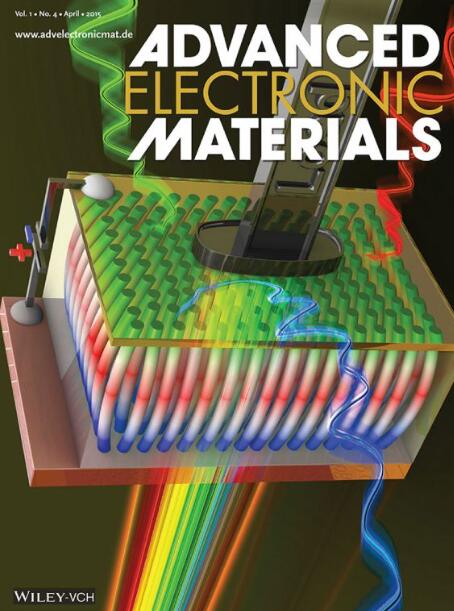有机异质结传感器中偏压诱导的双极性输运
IF 5.3
2区 材料科学
Q2 MATERIALS SCIENCE, MULTIDISCIPLINARY
引用次数: 0
摘要
有机异质结构中的界面工程是调整有机电子器件特性和提高其在气体传感等应用中性能的重要方法。本文结合电化学和 PVD 方法,合成了含有聚卟吩(pZnP-1)、全氟铜酞菁(Cu(F16Pc))和双镥酞菁(LuPc2)的有机异质结构,用于研究电荷传输和氨气(NH3)传感应用。pZnP-1 是通过受控氧化电聚合合成的,表面粗糙,这影响了其与酞菁界面的电学性质。异质结器件的电学特性显示出截然不同的界面和体电荷传输特性,这些特性受 pZnP-1 厚度和外部电场的调节。事实上,含有 pZnP-1 薄膜的异质结器件在低偏压时显示出 n 型特性,而在高偏压时则显示出 p 型特性;即伏极特性,伏极特性由外部电场触发。另一方面,具有厚 pZnP-1 薄膜的异质结器件在所有研究偏压下都表现出 p 型行为。对异质结器件的 NH3 传感特性的研究凸显了在异质结构中引入 pZnP-1 的优势,它提高了传感器的灵敏度、稳定性、可重复性和耐湿性。本文章由计算机程序翻译,如有差异,请以英文原文为准。
Bias Induced Ambipolar Transport in Organic Heterojunction Sensors
Interface engineering in organic heterostructures is an important approach to tuning the characteristics of organic electronic devices and improving their performances in applications, such as gas sensing. Herein, organic heterostructures containing, a polyporphine (pZnP‐1), perfluorinated copper phthalocyanine (Cu(F16 Pc)), and lutetium bis‐phthalocyanine (LuPc2 ) are synthesized by a combination of electrochemical and PVD methods for investigation of charge transport and ammonia (NH3 ) sensing application. pZnP‐1 is synthesized by controlled oxidative electropolymerization and reveals a rough surface, which influences the electrical nature of its interface with the phthalocyanine. The electrical properties of the heterojunction devices reveal distinct interfacial and bulk charge transport properties, which are modulated by the thickness of pZnP‐1 and the external electric field. Indeed, the heterojunction device containing a thin film of pZnP‐1 displays n‐type behavior at low bias and p‐type nature at higher bias; i.e., an ambipolar behavior, in which ambipolarity is triggered by the external electric field. On the other hand, the heterojunction device having a thick film of pZnP‐1 exhibits p‐type behavior at all the studied biases. Investigation of NH3 sensing properties of the heterojunction devices highlights the advantages of introducing pZnP‐1 in the heterostructures, which enhances the sensitivity, stability, repeatability, and humidity tolerance of the sensors.
求助全文
通过发布文献求助,成功后即可免费获取论文全文。
去求助
来源期刊

Advanced Electronic Materials
NANOSCIENCE & NANOTECHNOLOGYMATERIALS SCIE-MATERIALS SCIENCE, MULTIDISCIPLINARY
CiteScore
11.00
自引率
3.20%
发文量
433
期刊介绍:
Advanced Electronic Materials is an interdisciplinary forum for peer-reviewed, high-quality, high-impact research in the fields of materials science, physics, and engineering of electronic and magnetic materials. It includes research on physics and physical properties of electronic and magnetic materials, spintronics, electronics, device physics and engineering, micro- and nano-electromechanical systems, and organic electronics, in addition to fundamental research.
 求助内容:
求助内容: 应助结果提醒方式:
应助结果提醒方式:


